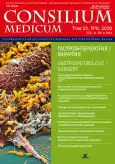Tuberculous peritonitis. Identification difficulties
- Authors: Plotkin D.V.1,2, Reshetnikov M.N.1, Sokolina I.A.1, Ziuzia I.R.1, Stepanov E.A.2, Belentseva O.V.1, Gafarov U.O.1, Sinitsyn M.V.1
-
Affiliations:
- Moscow Research and Clinical Center for Tuberculosis Control
- Pirogov Russian National Research Medical University
- Issue: Vol 21, No 8 (2019)
- Pages: 108-115
- Section: Articles
- URL: https://journals.rcsi.science/2075-1753/article/view/96872
- DOI: https://doi.org/10.26442/20751753.2019.8.190343
- ID: 96872
Cite item
Full Text
Abstract
Full Text
##article.viewOnOriginalSite##About the authors
Dmitrii V. Plotkin
Moscow Research and Clinical Center for Tuberculosis Control; Pirogov Russian National Research Medical University
Email: kn13@list.ru
Cand. Sci. (Med.) Moscow, Russia
Mikhail N. Reshetnikov
Moscow Research and Clinical Center for Tuberculosis ControlCand. Sci. (Med.) Moscow, Russia
Irina A. Sokolina
Moscow Research and Clinical Center for Tuberculosis ControlCand. Sci. (Med.) Moscow, Russia
Iuliia R. Ziuzia
Moscow Research and Clinical Center for Tuberculosis ControlCand. Sci. (Med.) Moscow, Russia
Evgenii A. Stepanov
Pirogov Russian National Research Medical UniversityCand. Sci. (Med.) Moscow, Russia
Olga V. Belentseva
Moscow Research and Clinical Center for Tuberculosis Controlsurgeon Moscow, Russia
Umedzhon O. Gafarov
Moscow Research and Clinical Center for Tuberculosis ControlCand. Sci. (Med.) Moscow, Russia
Mikhail V. Sinitsyn
Moscow Research and Clinical Center for Tuberculosis Controlканд. мед. наук, дир. Moscow, Russia
References
- Синицын М.В., Белиловский Е.М., Соколина И.А. и др. Внелегочные локализации туберкулеза у больных ВИЧ-инфекцией. Туберкулез и болезни легких. 2017; 95 (11): 19-25. https://doi.org/10.21292/2075-1230-2017-95-11-19-25 @@Sinitsyn M.V., Belilovskii E.M., Sokolina I.A. et al. Vnelegochnye lokalizatsii tuberkuleza u bol'nykh VICh-infektsiei. Tuberkulez i bolezni legkikh. 2017; 95 (11): 19-25. https://doi.org/10.21292/2075-1230-2017-95-11-19-25 (in Russian).]
- Aguado J.M, Pons F, Casafont F. Tuberculous peritonitis: a study comparing cirrhotic and noncirrhotic patients. J Clin Gastroenterol 1990; 12: 550.
- Getahun H, Gunneberg C, Granich R, Nunn P. HIV infection associated tuberculosis: the epidemiology and the response. Clin Infect Dis 2010; 50 (3): 201-7. doi: 10.1086/651492
- Ködmön C, Zucs P, Van der Werf M.J. Migration-related tuberculosis: Epidemiology and characteristics of tuberculosis cases originating outside the European Union and European Economic Area, 2007 to 2013. Euro Surveill 2016; 21. doi: 10.2807/1560-7917.ES.2016.21.12.30164
- Vaid U, Kane G.C. Tuberculous Peritonitis. Microbiology Spectrum 2017; 5. doi: 10.1128/microbiolspec.TNMI7-0006-2016
- Srivastava U, Almusa О, Ka-wah Tung, Heller М.Т. Tuberculous peritonitis. Radiology Case Reports 2014; 9 (3): 971. https://doi.org/10.2484/rcr.v9i3.971
- Sanai F.M, Bzeizi K.I. Systematic review: Tuberculous peritonitis - Presenting features, diagnostic strategies and treatment. Aliment Pharmacol Ther 2005; 22: 685-700. doi: 10.1111/j.1365-2036.2005.02645.x
- Cavalli Z, Ader F, Valour F et al. Clinical presentation, diagnosis, and bacterial epidemiology of peritoneal tuberculosis in two university hospitals in France. Infect Dis Ther 2016; 5: 193-9. doi: 10.1007/s40121-016-0113-2
- Савоненкова Л.Н., Арямкина О.Л. Клиника, патогенетические аспекты туберкулеза органов пищеварения. Проблемы туберкулеза и болезней легких. 2005; 6: 42-5. @@Savonenkova L.N., Ariamkina O.L. Klinika, patogeneticheskie aspekty tuberkuleza organov pishchevareniia. Problemy tuberkuleza i boleznei legkikh. 2005; 6: 42-5 (in Russian).
- Нечаева О.Б. Эпидемическая ситуация по туберкулезу среди лиц с ВИЧ-инфекцией в Российской Федерации. Туберкулез и болезни легких. 2017; 95 (3): 13-9. https://doi.org/10.21292/2075-1230-2017-95-3-13-19 @@Nechaeva O.B. Epidemicheskaia situatsiia po tuberkulezu sredi lits s VICh-infektsiei v Rossiiskoi Federatsii. Tuberkulez i bolezni legkikh. 2017; 95 (3): 13-9. https://doi.org/10.21292/2075-1230-2017-95-3-13-19 (in Russian)
- Ленский Е.В. Абдоминальный туберкулез: трудности диагностики. Сиб. мед. журн. 2006; 59 (1): 5-10.@@Lenskii E.V. Abdominal'nyi tuberkulez: trudnosti diagnostiki. Sib. med. zhurn. 2006; 59 (1): 5-10 (in Russian).
- Kaya M, Kaplan M.A, Isikdogan A, Celik Y. Differentiation of tuberculous peritonitis from peritonitis carcinomatosa without surgical intervention. Saudi J Gastroenterol 2011; 17 (5): 312-7. doi: 10.4103/1319-3767.84484
- Salgado Floresa L, Hernández Solísa А, Escobar А. Peritoneal tuberculosis: A persistent diagnostic dilemma, use complete diagnostic methods. Revista Médica del Hospital General de México 2015; 78 (2): 55-61. https://doi.org/10.1016/j.hgmx.2015.03.009
- Chow K.M, Chow V.C, Szeto C.C. Indication for peritoneal biopsy in tuberculous peritonitis. Am J Surg 2003; 185: 567.
- Shen Y.C, Wang T, Chen L. Diagnostic accuracy of adenosine deaminase for tuberculous peritonitis: a meta-analysis. Arch Med Sci 2013; 9: 601. doi: 10.5114/aoms.2013.36904
- Kaushik R, Punia R, Mohan H, Attri A.K. Tuberculous abdominal cocoon - a report of 6 cases and review of the Literature. World J Emergency Surg 2006; 1: 18. doi: 10.1186/1749-7922-1-18
- Koc S, Beydilli G, Tulunay G. Peritoneal tuberculosis mimicking advanced ovarian cancer: a retrospective review of 22 cases. Gynecol Oncol 2006; 103: 565. doi: 10.1186/1756-0500-6-88
- Okamoto K, Hatakeyama S. Tuberculous Peritonitis. N Engl J Med 2018; 379: 20-1. doi: 10.1056/NEJMicm1713168
- Peng-Hui Wang. Tuberculous peritonitis should always be considered as a differential diagnosis in abdominal carcinomatosis. Taiwan J Obstet Gynecol 2004; 43 (3): 182. doi: 10.1016/S1028-4559(09)60083-8
- Sotoudehmanesh R, Shirazian N, Asgari A.A. Tuberculosis peritonitis in an endemic area. Digestive Liver Dis 2003; 35: 37-40. https://doi.org/10.1016/S1590-8658(02)00010-5
- Савоненкова Л.Н., Анисимова С.В., Сидорова Ю.Д. и др. Летальность больных туберкулезом в условиях эпидемии ВИЧ-инфекции. Ульяновский медико-биологический журн. 2018; 3: 99-106. @@Savonenkova L.N., Anisimova S.V., Sidorova Iu.D. et al. Letal'nost' bol'nykh tuberkulezom v usloviiakh epidemii VICh-infektsii. Ul'ianovskii mediko-biologicheskii zhurn. 2018; 3: 99-106 (in Russian).
Supplementary files






